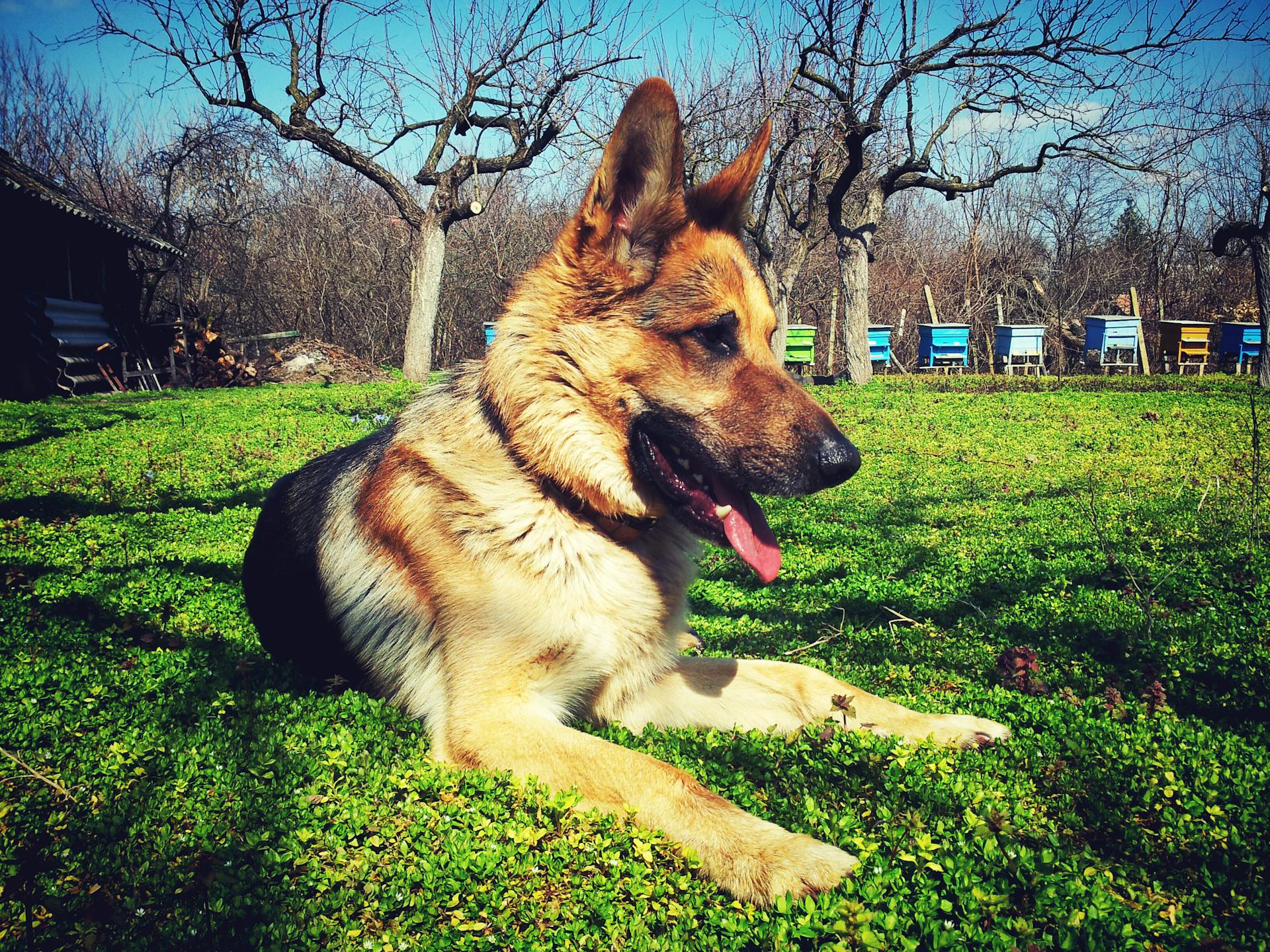
If your dog ate Tomcat rat poison, it's essential to know the risks and what to do next.
Tomcat rat poison contains a toxic compound called brodifacoum, which can cause internal bleeding and other severe health issues in dogs.
The severity of the symptoms depends on the amount of poison ingested, with even small amounts potentially causing harm.
If you suspect your dog has ingested Tomcat rat poison, contact your veterinarian or a pet poison hotline immediately for guidance and support.
Types of Rodenticides
Types of Rodenticides can be broadly categorized into three main types in the UK. Anticoagulant baits are one such type that cause bleeding by preventing the blood from clotting.
If you suspect your dog has ingested rat poison, it's essential to know what type of poison it is. Anticoagulant baits are just one of the many types of rodenticides out there.
Some rodenticides, like Zinc and Aluminum Phosphides, are more commonly found in mole or gopher baits but can also appear in mouse and rat baits. These poisons release phosphine gas in the stomach, which can lead to serious health issues.
Common Types of Rodenticides:
Bromethalin
Bromethalin is a type of rodenticide that can be particularly hazardous to animals. It works by increasing sodium in the body, causing the animal to swell and die.
This toxin primarily affects the brain, resulting in neurological symptoms.
In small doses, it can take weeks for symptoms to appear, but large doses can be rapidly fatal, with symptoms showing within 2 to 36 hours.
Common symptoms of bromethalin poisoning include lethargy, pressing their head against furniture, anxiety, ataxia, tremors, loss of appetite, seizures, paralysis, vomiting, and coma.
Be aware that bromethalin has a narrow margin of safety and can even cause moderate toxicity from skin exposure.
Curious to learn more? Check out: Bromethalin Rat Poison Dog
Phosphide
Phosphide is a type of rat poison that's often used by professionals to get rid of moles and gophers. It's less common than other types of rodenticides, but still poses a significant risk to dogs if ingested.
This type of poison releases phosphide gas once it's in the stomach, which can cause a range of symptoms including stomach bloating, vomiting, abdominal pain, shock, collapse, seizures, and liver damage.
Feeding your dog after ingestion of phosphide is never a good idea, as it can increase the amount of gas produced and make the poison even more toxic.
If you suspect your dog has ingested phosphide, make sure they're in a well-ventilated area or outside in case they vomit. If you're in the car, roll down the window to prevent inhalation of the phosphine gas.
Here are some common signs of phosphide poisoning in dogs:
- Stomach bloating
- Vomiting (which can cause lung irritation to both the dog and the pet owner)
- Abdominal pain
- Shock
- Collapse
- Seizure
- Liver damage
Strychnine
Strychnine is a highly toxic substance that's primarily used by professionals for underground rodent control. It's not commonly used, due to strict regulations and restrictions.
Strychnine affects the spinal cord, leading to severe spasms that can cause breathing paralysis and even death. This can be a serious consequence of strychnine poisoning.
Symptoms of strychnine poisoning include stiffness, agitation, vomiting, seizures, rigid standing, convulsions, asphyxiation, hyperthermia, and hemorrhaging. These symptoms can be distressing and even life-threatening.
Strychnine is particularly toxic to dogs, with a lethal dose as low as 0.5 mg per kg. This highlights the importance of using strychnine with caution and only in areas where pets are not present.
Here's a list of symptoms associated with strychnine poisoning:
- Stiffness
- Agitation
- Vomiting
- Seizures
- Rigid standing
- Convulsions
- Asphyxiation (suffocation)
- Hyperthermia (overheating)
- Hemorrhaging
Symptoms and Signs of Poisoning
If your dog ate tomcat rat poison, it's essential to recognize the symptoms and signs of poisoning. Your dog's symptoms will differ based on the type of poison they ate, but some common signs include lethargy, weakness, loss of appetite, increased thirst and urination, bad breath, pale gums, vomiting, blood in urine, and tremors.
The color of your dog's stool can also be a giveaway. If their poop is bright blue, green, purple, pink, or teal, it's likely they ate rat poison or another rodenticide. This is because rat poisons are often colored to make them more visible.
Your dog may also experience secondary poisoning if they eat a poisoned rodent. This is rare, but it depends on several factors, including the toxicity of the rodenticide, the amount of toxin, and when the rodent ate the poison.
Some common symptoms of secondary poisoning include lethargy, weakness, loss of appetite, increased thirst and urination, and pale gums.
Explore further: Signs and Symptoms of Aging Dogs
Here are some common symptoms of rat poisoning in dogs:
- Lethargy
- Weakness
- Loss of appetite
- Increased thirst and urination
- Bad breath
- Pale gums
- Vomiting
- Blood in urine
- Tremors
It's worth noting that internal bleeding can also occur, which may cause lethargy, weakness, or breathing difficulties. This can happen a few days after the rat poison has been eaten, so it's essential to monitor your dog's behavior and seek veterinary attention if you suspect poisoning.
Treatment and Prevention
Treatment for rat poisoning in dogs is a serious matter that requires immediate veterinary attention. If your dog has ingested rat poison, it's essential to visit a conventional or emergency clinic as soon as possible.
Your vet may induce vomiting and administer charcoal to help absorb the poison, and prescribe vitamin K1 for 30 days to counteract the effects of anticoagulants. However, if your dog has ingested cholecalciferol, hospitalization and lab monitoring are necessary, and treatment may include IV fluids, diuretics, and steroids.
Prevention is the best way to protect your dog from rat poison. Keep rat poison off your property, and if you must use it, store it in a safe place where your dog can't find it.
A different take: Dog Flea Treatment Overdose Symptoms
Here are some tips to keep your dog safe:
- Keep rat poison off your property.
- Find out whether your city uses rat poison and where.
- Supervise your dog at all times when you're off your property.
- Store rat poison in a safe place where your dog can't find it.
- Keep your dog in a crate or safe room when unsupervised.
Treatment for Poisoning
If your dog has eaten rat poison, it's essential to seek veterinary attention immediately. This is a serious situation that shouldn't be managed at home.
The type of treatment your dog needs will depend on the type of rat poison they ingested. Anticoagulant poisoning has a high survival rate and a known antidote, which may include inducing vomiting and administering charcoal to absorb the poison.
For cholecalciferol poisoning, there's no antidote, so hospitalization, lab monitoring, and expensive therapies are necessary. This may include IV treatment, diuretics, bisphosphonates, steroids, and other treatments.
Bromethalin poisoning also requires hospitalization, and treatment may involve induced vomiting, IV, and charcoal. Your vet may also use medication to reduce brain swelling and seizures.
Your vet will need to run tests to determine which type of rat poison your dog ingested. This may include blood clotting tests, fecal analysis, or analysis of kidney, liver, brain, and fat tissue.
Intriguing read: Treatment for Dog Poisoned by Rat Poison
Here's a summary of the different types of rat poison and their corresponding treatments:
It's crucial to follow your vet's instructions and keep a close eye on your dog's symptoms and treatment progress.
How to Prevent
Preventing rat poison exposure is crucial to keep your furry friend safe. Keep rat poison off your property, as it's the best way to protect your dog from accidental ingestion.
If you can't avoid rat poison altogether, store it in a safe place where your dog can't find it. This is especially important if your dog is prone to getting into things they shouldn't.
Supervise your dog at all times when you're off your property, as this can help prevent accidental exposure. You can also find out whether your city uses rat poison and where it's used, which can help you take extra precautions.
If you do have to use rat poison, store it in a secure location and keep your dog in a crate or safe room when you're not supervising them. This can help prevent your dog from getting into the poison.
Here are some additional tips to keep in mind:
- Keep the packaging of rat poison on hand in case your dog ingests some, as this can make identification easier.
- Consider contacting a professional to find out about pet-safe options for rodent removal.
- Keep rat poison and traps in a large enough cage so your dog can't reach them.
Remember, rat poison can be fast-acting and deadly, so it's essential to take these precautions seriously.
What to Do
If you suspect your dog has eaten rat poison, try to bring in a sample when you go to the vet. Even if you can't get a sample, your vet can still run tests to determine which type of poison your dog ingested.
Your vet will use their expertise, your dog's symptoms, and any information you can provide to decide which tests to run. They may do a blood clotting test to check for anticoagulants, which can be detected through clotting problems.
If your vet suspects cholecalciferol poisoning, they'll run a series of blood tests to confirm the levels of calcium and phosphorus in your dog's blood.
What to Do If Your Dog Eats Something
If your dog eats something toxic, acting fast is crucial. Call your vet immediately, even if your dog looks fine.
Don't try to induce vomiting unless your vet tells you to, as this can damage your dog's esophagus or release toxins into the air.
Bring a sample of the toxic substance and its packaging to your vet, if possible, to help identify it. Be sure to handle the sample safely, as some toxins can cause harm through skin contact.
Your vet may not always be able to identify the toxin, so they'll run tests based on your dog's symptoms and any information you can provide.
If you think your dog was poisoned in a public space, contact your city to see if they use rodenticides or rat poison in that area.
Your vet can do blood tests to check for certain toxins, such as anticoagulants, cholecalciferol, bromethalin, phosphide, and strychnine.
What to Tell Us When You Call
If you're calling Animal PoisonLine, it's a good idea to have the product name on hand. This information can usually be found on the packet or online.
The active ingredient and strength of the product are also crucial details to provide. You can find this information on the packet or by searching online.
Knowing how much of the bait your pet has eaten in grams is also important to share with Animal PoisonLine. This will help them assess the situation accurately.
Understanding Poisoning
If your dog ate Tomcat rat poison, it's essential to understand the potential symptoms and effects of poisoning. One of the most distinctive symptoms is brightly colored stools, which can be a sign that your dog has ingested rat poison.
The type of rat poison your dog ate can affect the symptoms they experience. Anticoagulants, for example, can cause delays in blood clotting, leading to bleeding internally or externally.
If your dog is bleeding internally, they may show signs of lethargy, weakness, or paleness, or experience breathing difficulties. If bleeding occurs in the joints, your dog may show signs of lameness.
Here are some common symptoms of rat poisoning in dogs:
- Lethargy
- Weakness
- Loss of appetite
- Increased thirst and urination
- Bad breath
- Pale gums
- Vomiting
- Blood in urine
- Tremors
It's crucial to note that some rat poisons, like cholecalciferol, have no antidote and require hospitalization and expensive therapies. Others, like anticoagulants, have a known antidote and may require induced vomiting and charcoal administration.
Secondary Poisoning from Food
Secondary poisoning from food can occur when your dog eats a poisoned rodent, which can happen to up to 67% of birds in Canada and 58% in the US.
The toxicity of the rodenticide, the amount of toxin, and when the rodent ate the poison are all factors that determine the likelihood of secondary poisoning.
If you suspect your dog has eaten a poisoned rodent, contact your vet right away.
Secondary poisoning is rare, but it's essential to be aware of the risks and take prompt action if you suspect your dog has been affected.
Bromethalin Toxicity in Vets
Bromethalin is a type of rat poison that can be particularly deadly for dogs. It increases sodium in the body, causing the animal to swell and die, often affecting the brain first.
Symptoms of bromethalin toxicity can be quite varied and may take weeks to appear in small doses, but can be rapidly fatal in large doses, appearing within 2 to 36 hours.
Common symptoms include lethargy, pressing their head against furniture, anxiety, ataxia, tremors, loss of appetite, seizures, paralysis, vomiting, and coma.
Bromethalin has a narrow margin of safety and can even cause moderate toxicity from skin exposure. It's essential to be aware of the potential for confusion with common anticoagulants like brodifacoum or bromadiolone.
Treatment for bromethalin poisoning may require hospitalization and can include induced vomiting, IV fluids, and charcoal. Vets may also use medication to reduce brain swelling and seizures. It can take several weeks to treat bromethalin poisoning.
Here are some key points to remember about bromethalin toxicity:
- Lethargy and pressing their head against furniture are common early symptoms.
- Seizures and coma can occur in severe cases.
- Treatment often requires hospitalization and can be lengthy.
- Induced vomiting and IV fluids are common treatments.
- Medication may be used to reduce brain swelling and seizures.
Frequently Asked Questions
How much tomcat rat poison will hurt a dog?
A small amount of Tomcat rat poison, as little as 1 ounce, can be fatal to a 70-pound dog, causing kidney damage within 1-3 days. If you suspect your dog has ingested Tomcat, seek veterinary attention immediately.
How long does it take for symptoms of rat poison in dogs?
Symptoms of rat poison in dogs typically appear 3-7 days after ingestion, due to blood loss. This delay is because it takes time for the body to use up vitamin K1 and clotting factors.
How do you flush poison out of a dog's system?
To flush poison out of a dog's system, a vet may use gastric lavage, charcoal, and enemas to remove the substance, while also administering IV fluids and pain medication as needed. This treatment aims to quickly and safely remove the poison and alleviate symptoms.
What is the antidote for Tomcat mouse poison?
There is no antidote for Tomcat mouse poison. Call Pet Poison Control ASAP for guidance on treatment and care.
Sources
- https://vetgirlontherun.com/bromethalin-toxicity-in-dogs-cats-vetgirl-veterinary-ce-blog/
- https://www.petpoisonhelpline.com/pet-safety-tips/mouse-and-rat-poison-rodenticides-poisonous-to-dogs-cats/
- https://www.dogsnaturallymagazine.com/dog-ate-rat-poison/
- https://www.animalpoisonline.co.uk/blogs/2018/02/08/help-what-should-i-do-if-my-dog-ate-rat-poison/
- https://greenbrier-emergency.com/rodenticide-toxins-rat-poison-pets/
Featured Images: pexels.com


